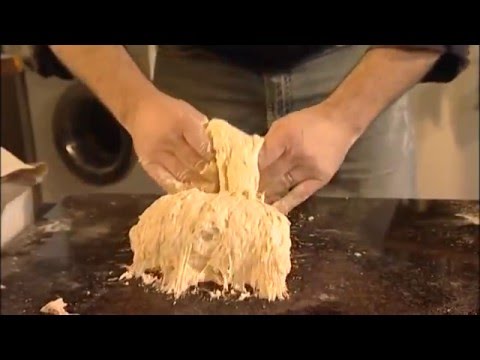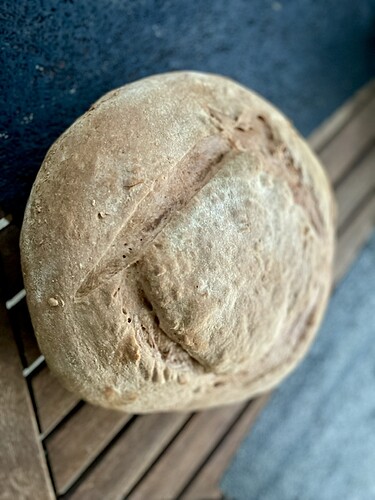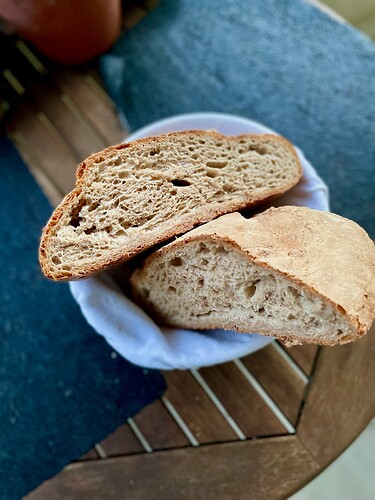With whole wheat you could add some extra gluten to get a better rise
If you order from King Arthur regularly, it’s probably worth the $40 a year for free shipping on all orders of $20 or more.
80% hydration using 15% hard red flour from Grist & Toll and 85% regular AP flour. Overnight cold ferment. 475 degrees.
Very tasty bread. The Grist & Toll flour adds a nice earthiness. The crust ended up being very crunchy and thicker than usual. Not that this was a bad thing. Wondering if this was from the overnight cold rise.
Beautiful loaf! I can practically smell it.
The overnight rise does develop gluten so that might have been the cause of the crust’s extra dimension. Did you use a steam pan? That gives both oven spring and a good crust.
Dutch oven covered for 30 mins than uncovered for 20 mins. I think this is our new favorite but still experimenting.
The heat of the pot would also contribute to a thicker crust.
I have to say that looks so much better than the first one you posted. Great job!
The latest Pullman / pan de mie with a bit of Red Fife and Reluctant Trading’s black pepper inclusion
Very light crumb; a little bien cuit i was baking in an unfamiliar oven. Over all in very happy how it came out.


Is that the overnight country blonde? I can’t recall if it was you or someone else, but I’ve read that Forkish likes to take things to a bit of an extreme. I like the flavor of the overnight country blonde, but the results can be very variable (and I realize that that applies to any bread using a starter).
Will look at the other recipe you mentioned…
Okay, I can get behind a recipe w/ only one prove! I don’t think my start is strong enough for two.
Perhaps a silly question, but can I just shape a dough from a baguette recipe into a boule?
It’s “White Bread made with Poolish”.
I use the same dough for baguettes, boules, and ciabattas.
A warning though - these are high hydration doughs and tend to slump if not supported. If you are baking your boule in a Dutch Oven, no problem, but if its freeform you will probably end up with a fat pancake.
Oh, that title is simple enough. Heh. ![]()
Oh, when things are very bad, I get the pancake even with the dutch oven. But, in those cases, I usually suspect beforehand that I’ve totally over-proved…
When I read on The Fresh Loaf a few yrs ago that a poster just made a few folds whenever (the Tartine recipe is very… picky) and then skipped the second prove entirely, it bordered on life-changing.
My shaping still stinks, though. ![]()
Stretch and fold…does wonders for gluten development. Do you use a banneton? Also I have found with boules that a smaller Dutch Oven works a lot better.
I am also a big fan of the slap and fold. RB’s book Crust was the first bread book i had and still think he’s a good teacher
No. I have 2 nice bannetons, but my dough always sticks so badly that I use Saran wrap to use the removal… which then seems to defeat the purpose of the banneton. Do you think using a banneton makes a big difference?
To all: my first attempt at bread since the pandemic started. I used 75 deg water, and I kneaded more aggressive than usual when mixing in the starter after autolyze. For possibly the first time ever, the dough actually folded neatly! I could actually see some large air pockets (that stayed intact) when I shaped… And it also shaped well, too (that almost never happens for me). I thought, this is looking good!
I was reading an on-line blog about Ken Forkish’s overnight country blonde recipe, and it said to do the final proving in the fridge (4 hrs). My dough is often an overproved mess at the end of the 2nd proving, so I did this.
Loaf held its shape decently and scored fairly easily (also usually a prob point for me). Def not underproved overproved (typing too fast)…
Loaf had decent oven spring, but I was a bit worried when I pulled it out. I left it cook a little longer, (by 5 mins) than I usually do, and the internal temp wouldn’t go above 210. Thermometer was had a good amount of dough when I pulled it out. And it looks a bit flattish on top. But there were little air bubbles everywhere. ![]() Hmmm…
Hmmm…
Let it cool for several hrs in the oven when door propped open.
Partner cuts into and is like, “This is REALLY dense.” And, yup, SO gummy and dense in the middle. You can see where the dough was trying to rise through the scoring.
I think the mistake was doing the 2nd proof in the fridge. Will try again later this wk (planning to bring bread to a party) and will do proof at room temp (which is still pretty damn cold in my kitchen).
Pics after a few secs after final fold, after 15 hr rise, after 2nd prove, right b/f plopping it in dutch oven. The rest of the pics are self explanatory.
Beautiful!
I smothered my bannetons with flour as Ken Forkish recommends. They stuck a little at first but now I have no trouble.
I’ll try the banneton for the non party bread. ![]() I also have lovely couche that I’ve never used!
I also have lovely couche that I’ve never used!
I also think I’m going to inc the water temp to 80 deg (which is still below the recommeneded 85-90). A few wks ago, my dough to be slack mess when I used higher temps, but my current batch of yeast/starter seems to be hardier.
Will post pics. Wish me luck, everyone. ![]()
To be honest I just guess at the water temp. It doesn’t seem to make that much difference.
Best of luck!
WHAT??? Ohmigod, some of the stuff I read say that temp should be treated as an ingredient and that you should do calcs to adjust prove time based on temp differences.
Although, I have to say, I think the room temp is more important than water temp.
Okay, for everyone else, here’s attempt #2. Pics are after an overnight prove and then the rest are self explanatory. Less aggressive mixing, 2 less complete sets of folds, 80 deg water, 2nd prove at room temp for ~4 hrs.
It’s not obvious from the pic, but I got better browning this time around. I prob let the 2nd prove go on just a bit too long. The dough started “oozing” after a minute or so out of the bowl. So scoring didn’t do much (prob shouldn’t have scored it at all). As I was trying to throw it in the dutch oven and actually stuck to the side of the pot!!! Thankfully, no big deal (just used a spatula to detach it).
Not as much oven spring as the first loaf, but the crust stayed nice and hard and the crumb was moist but not dense and gummy. Baked it for a party, and the guests were very pleased (as was I).
For the next time, I think I’ll probably toss it in the fridge b/f baking so that it keeps its shape better.
Just my experience.
Your loaf looks lovely!
I’ve been messing around with a straight dough formula i found in an m old michel Richard book -the man was a genius, of course many of his recipes don’t really work with out major tweaking though. My impression is that he was worried about people stealing his work. He’s got tons of great ideas so for me at least it’s worth mining for inspiration!
This is still very much a work in progress but the flavor is great. Anyway I’ve made some changes so any faults are my own.
Not the exact formula but it’s about 60% bread flour 20% whole wheat, 20% rye 80% water













